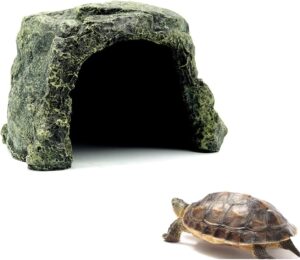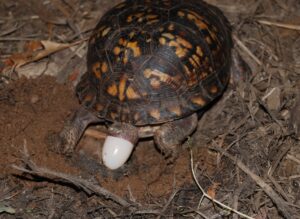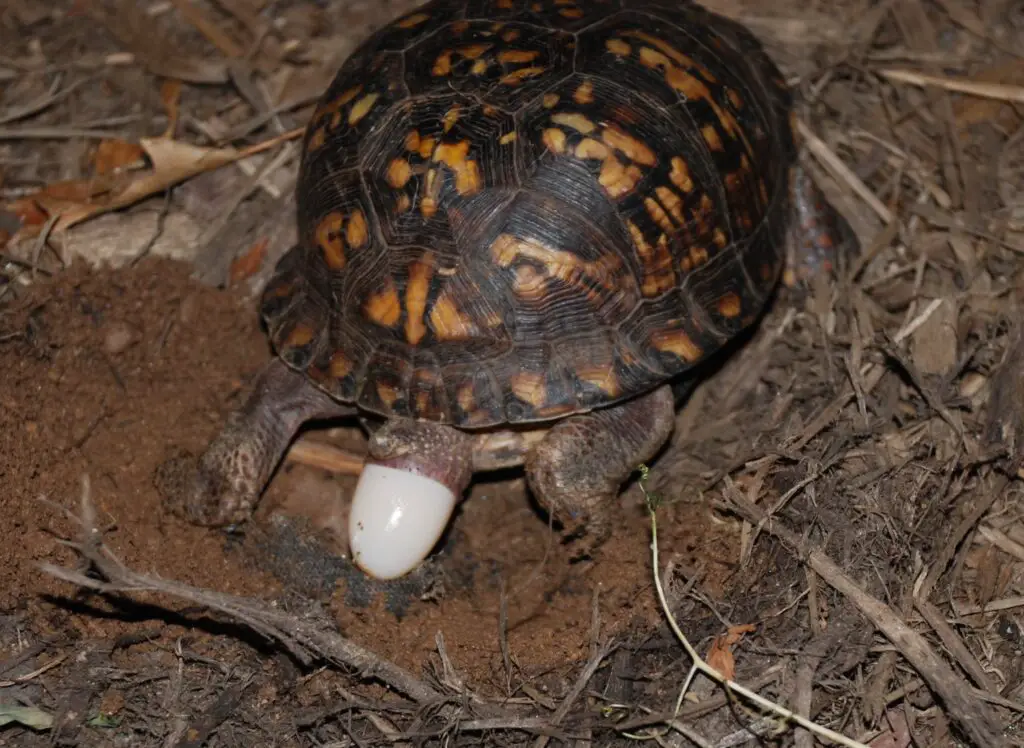How long do box turtle eggs take to hatch
How long do box turtle eggs take to hatch: Box turtles, with their fascinating characteristics and unique reproductive process, have long captivated the curiosity of nature enthusiasts and biologists alike. These terrestrial reptiles belong to the family Emydidae and are known for their distinctive domed shells that serve as a protective shield.
Box turtles can be found in various regions across North America, including forests, grasslands, and even suburban areas. The reproductive process of box turtles is an intricate affair that involves courtship rituals, egg laying, and the subsequent incubation period.
Understanding the intricacies of this process is essential for researchers and conservationists to effectively manage populations of these remarkable creatures. By delving into the depths of box turtle reproduction, we gain insights into fundamental aspects such as their survival strategies, population dynamics, and habitat requirements.
Brief Overview of Box Turtles and Their Reproductive Process
 The reproductive cycle of box turtles begins in early spring when males emerge from their winter hibernation sites in search of potential mates. They engage in elaborate courtship displays to attract females which may involve head bobbing, circling movements, or even gentle biting. Once courtship is successful and mating occurs, female box turtles embark on a journey to find suitable nesting sites.
The reproductive cycle of box turtles begins in early spring when males emerge from their winter hibernation sites in search of potential mates. They engage in elaborate courtship displays to attract females which may involve head bobbing, circling movements, or even gentle biting. Once courtship is successful and mating occurs, female box turtles embark on a journey to find suitable nesting sites.
Female box turtles exhibit site fidelity when it comes to selecting nesting locations. They often return to the same area year after year to lay eggs.
The nest site chosen by a female typically has specific characteristics such as well-drained soil with ample sunlight exposure for optimal incubation conditions. Box turtle eggs have soft shells that require protection from extreme environmental factors like harsh weather conditions or potential predators.
The female carefully excavates a hole using her hind legs where she deposits her clutch of eggs before covering them up with soil. This act ensures that the developing embryos are shielded from potential threats and are provided with a conducive environment for their growth.
Importance of Understanding the Incubation Period for Box Turtle Eggs
Knowledge about the incubation period of box turtle eggs holds immense significance in several aspects of research, conservation, and management strategies. The duration between egg deposition and hatching plays a crucial role in determining reproductive success and offspring survival.
Understanding the incubation period allows researchers to monitor population dynamics by estimating the number of individuals reaching maturity. It aids in assessing the health and viability of box turtle populations, identifying potential threats to their survival, and implementing effective conservation measures accordingly.
Furthermore, comprehending the factors that influence incubation time provides valuable insights into how environmental conditions affect reproductive processes. This knowledge helps scientists predict how box turtles might respond to changes in their habitat due to human activities or climate fluctuations.
Box Turtle Reproduction
The Art of Courtship: Mating Behavior and Courtship Rituals
Box turtles, with their intriguing courtship rituals, demonstrate a fascinating repertoire of behaviors that lead to successful mating. The process begins with the males actively seeking out potential mates during the breeding season, which typically occurs in late spring or early summer.
These tenacious suitors embark on a quest to locate receptive females through their heightened sense of smell and visual cues. Once a potential mate is detected, the courtship dance commences.
Male box turtles engage in impressive displays to capture the attention of females. This elaborate performance involves head-bobbing, circling, and even gentle biting in some cases.
The male showcases his vibrant colors and ornate patterns while simultaneously emitting low-frequency vocalizations to further entice his desired partner. During this intricate spectacle, the female box turtle observes her suitor’s behavior closely.
If she finds him suitable, she responds by exhibiting submissive gestures such as neck stretching or head retracting motions. This communication helps establish a mutual understanding between the pair before copulation can take place.
Beneath the Surface: Laying Eggs in Underground Nests
 After successful copulation, female box turtles proceed to lay their eggs in carefully selected underground nests. The choice of nest location is essential for ensuring optimal conditions for embryonic development and protection against predators.
After successful copulation, female box turtles proceed to lay their eggs in carefully selected underground nests. The choice of nest location is essential for ensuring optimal conditions for embryonic development and protection against predators.
Using her hind limbs, the female excavates a hole in soft soil or sand that may be up to 6 inches deep. She meticulously shapes the nest by rotating her body while simultaneously depositing her eggs one by one into the prepared cavity.
The number of eggs laid varies depending on factors such as age, size, and species of box turtle; however, clutches typically range between four and eight eggs per nesting event. Once all the eggs are laid within the nest chamber, the female carefully covers them with soil using her hind legs, taking great care not to damage or disturb the delicate embryos.
The process of laying eggs and burying them in an underground nest is crucial for maintaining the optimal temperature and humidity required for successful incubation. The mother’s meticulous efforts ensure that her offspring have the best possible chance of survival in this challenging world.
By understanding the intricacies of box turtle reproduction, we gain a deeper appreciation for their fascinating courtship rituals and the careful nurturing exhibited by female box turtles during egg-laying. These remarkable behaviors contribute to the continuation of their species and provide insights into their evolutionary adaptations.
Incubation Period of Box Turtle Eggs
Understanding the incubation period of box turtle eggs is crucial for their successful hatching and survival. The incubation period refers to the time it takes for the eggs to develop and hatch into baby turtles. This period varies depending on several factors including temperature, moisture levels, and even the specific species of box turtle.
Factors influencing the duration of incubation
The duration of incubation for box turtle eggs can be influenced by various factors. One primary factor is temperature.
Box turtles are known as ectothermic animals, meaning their body temperature is regulated by their environment. The ambient temperature plays a crucial role in determining the rate at which embryos develop within the eggs.
Generally, warmer temperatures tend to accelerate embryo development, resulting in shorter incubation periods. Conversely, cooler temperatures slow down development and prolong incubation time.
Another factor that affects the duration of incubation is moisture levels within the nest environment. Adequate moisture is essential for embryo growth and development in box turtle eggs.
If the nest becomes too dry, it can lead to dehydration or stunted growth of embryos, ultimately extending the overall incubation period. On the other hand, excessive moisture might create an environment prone to fungal or bacterial infections which can be detrimental to egg viability.
Temperature and its impact on egg development
The influence of temperature on egg development cannot be overstated when discussing box turtle embryos’ growth inside their shells during incubation. Within a certain range of temperatures suitable for each species, higher temperatures generally result in faster embryonic development while lower temperatures cause developmental delays. In general, an optimal temperature range exists for effective embryonic growth in box turtles whereby they experience normal physiological processes necessary for healthy offspring production.
Deviations from this range may disrupt critical developmental stages and lead to abnormalities or even death of the developing embryos. It is important to note that the relationship between temperature and incubation duration is not linear.
At extremely high temperatures, development may be negatively impacted, leading to deformities or mortality. Likewise, very low temperatures may induce prolonged diapause, a state of suspended development where embryos remain dormant until more favorable conditions arise.
Moisture levels and their effect on embryo growth
The role of moisture levels during incubation is closely tied to the health and development of box turtle embryos. Adequate moisture within the nest environment helps maintain proper hydration levels for the eggs and supports various physiological processes within the developing embryos. If moisture levels are too low, eggs can lose water through evaporation, which can result in dehydration and adversely affect embryonic growth.
Insufficient moisture might also lead to a lack of necessary nutrients reaching the embryos, hindering their overall development. Conversely, overly high moisture levels can create an environment where bacteria and fungi proliferate.
These pathogens can cause infections that harm or kill the embryos before they have a chance to hatch. Striking an appropriate balance in nest moisture is therefore crucial for ensuring healthy embryo growth throughout the incubation period.
Average Incubation Time for Box Turtle Eggs
General range of incubation periods across different species of box turtles
The length of the incubation period for box turtle eggs can vary depending on the species. On average, box turtle eggs take between 60 to 90 days to hatch.
However, it is important to note that this range is not set in stone and can be influenced by various factors such as temperature and moisture levels. Some species may have shorter or longer incubation times within this general range.
Eastern Box Turtles (Terrapene carolina)
Among the various box turtle species, Eastern Box Turtles (Terrapene carolina) are known to have a relatively long incubation period compared to others. The average incubation time for Eastern Box Turtle eggs can range from 70 to 90 days. However, it is essential to consider that environmental conditions play a significant role in determining the exact duration.
Three-Toed Box Turtles (Terrapene carolina triunguis)
Three-Toed Box Turtles (Terrapene carolina triunguis) typically have a slightly shorter incubation period compared to Eastern Box Turtles. The average time it takes for Three-Toed Box Turtle eggs to hatch ranges from approximately 60 to 80 days. However, as with other species, external factors influence the precise duration.

Ornate Box Turtles (Terrapene ornata)
Ornate Box Turtles (Terrapene ornata) exhibit similar average incubation times when compared to other box turtle species. The typical range for Ornate Box Turtle eggs is around 65 to 85 days before they hatch.
As with all turtles, the specific environmental conditions during incubation significantly impact these timings. It must be emphasized that these average incubation times are subject to variation due to external circumstances.
Factors such as temperature, humidity, and specific nesting conditions can influence the duration of egg incubation. Warmer temperatures tend to accelerate development, resulting in shorter incubation periods, while cooler conditions may prolong the process.
Additionally, excessively dry or overly moist environments can also affect the overall incubation time for box turtle eggs. It is crucial to provide optimal environmental conditions to ensure successful hatching and healthy offspring.
Unusual Cases and Variations in Incubation Time
Instances where box turtle eggs take longer than average to hatch
Box turtle eggs typically follow a predictable incubation period; however, there are instances where the hatching process deviates from the norm. One common factor that contributes to delayed hatching is cooler temperatures. If the nest environment experiences prolonged periods of lower temperatures, it can significantly slow down embryonic development.
This delay might be observed particularly in regions with colder climates or when nesting conditions fail to provide sufficient warmth. Additionally, inadequate nesting conditions such as poor soil quality or improper moisture levels can also impede incubation, leading to longer periods before hatching occurs.
Extended diapause phenomenon observed in some species
In certain box turtle species, an intriguing phenomenon known as extended diapause has been documented. Extended diapause refers to a prolonged period of developmental arrest experienced by embryos within their shells. This mechanism allows the eggs to remain dormant for an extended duration until favorable environmental conditions arise that trigger their development and subsequent hatching.
It’s believed that this adaptive strategy aids in survival during unfavorable seasons or when resources are scarce, increasing the chances of successful offspring production when conditions improve.
Factors Influencing Sex Determination in Box Turtle Eggs
Explanation of temperature-dependent sex determination (TSD) mechanism
 The fascinating process of sex determination in box turtles relies on temperature-dependent sex determination (TSD). Unlike mammals with fixed chromosomes determining gender, box turtles exhibit a remarkable ability where the ambient temperature during egg incubation influences the offspring’s sex.
The fascinating process of sex determination in box turtles relies on temperature-dependent sex determination (TSD). Unlike mammals with fixed chromosomes determining gender, box turtles exhibit a remarkable ability where the ambient temperature during egg incubation influences the offspring’s sex.
In most species, warmer temperatures predominantly produce female hatchlings while lower temperatures favor males. This unique mechanism showcases nature’s ingenuity and highlights the fascinating adaptations found within reptilian reproductive biology.
Discussion on how temperature affects the gender ratio in hatchlings
The impact of temperature on the gender ratio of box turtle hatchlings is a subject of great interest and scientific inquiry. Research indicates that specific temperature thresholds exist, known as pivotal temperatures, which determine the sex outcome.
For instance, if eggs are incubated within a narrow range slightly above the pivotal temperature, more females are likely to be produced. Conversely, temperatures below this range favor male production.
This delicate balance underscores the importance of maintaining optimal incubation conditions for box turtle eggs, as deviations can significantly skew the gender ratio and potentially affect population dynamics.
Caring for Box Turtle Eggs during Incubation
Tips for creating an artificial nest environment for captive breeding programs
Creating an artificial nest environment is essential when undertaking captive breeding programs for box turtles. To mimic natural conditions, it is crucial to use appropriate nesting materials such as soil or sand with sufficient moisture content to maintain proper humidity levels.
The nest should be securely enclosed and protected against predators while providing adequate airflow. Regular monitoring of temperature and humidity levels within the artificial nest is vital to ensure optimal incubation conditions, maximizing hatching success rates in captivity.
Guidelines for monitoring
Monitoring box turtle eggs during incubation involves regular inspection without excessive disturbance. Gentle handling allows careful assessment of egg condition, ensuring they are not damaged or infected by bacteria or fungi. Monitoring should include recording environmental variables such as temperature and humidity levels at regular intervals to identify any fluctuations or deviations from desired parameters promptly.
By closely observing the developing embryos over time, any unusual patterns or signs of distress can be detected early on and necessary interventions implemented to maximize their chances of survival.
To sum up how long do box turtle eggs take to hatch
In exploring how long box turtle eggs take to hatch, we have uncovered some fascinating aspects of their incubation. Unusual cases and variations in incubation time can occur due to cooler temperatures or inadequate nesting conditions. Additionally, the extended diapause phenomenon in certain species highlights the adaptability of box turtles to challenging environments.
The temperature-dependent sex determination mechanism further adds to the allure of these remarkable creatures. By understanding these factors and implementing proper care during incubation, we can contribute to the conservation efforts for box turtles while marveling at nature’s intricate processes.
Further Reading
How To Keep My Turtle Tank From Smelling
How To Decorate a Turtle Tank: DIY Guide


